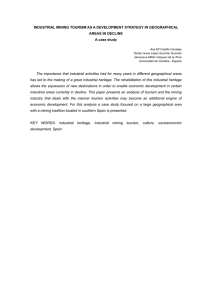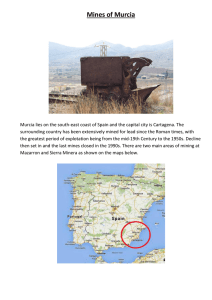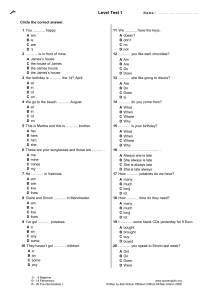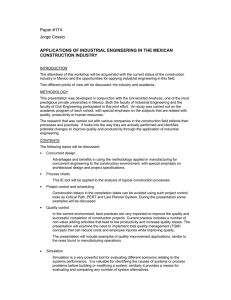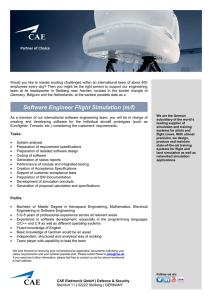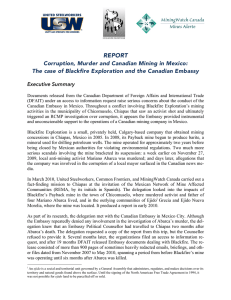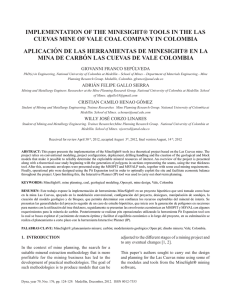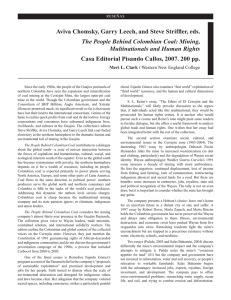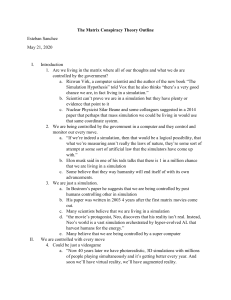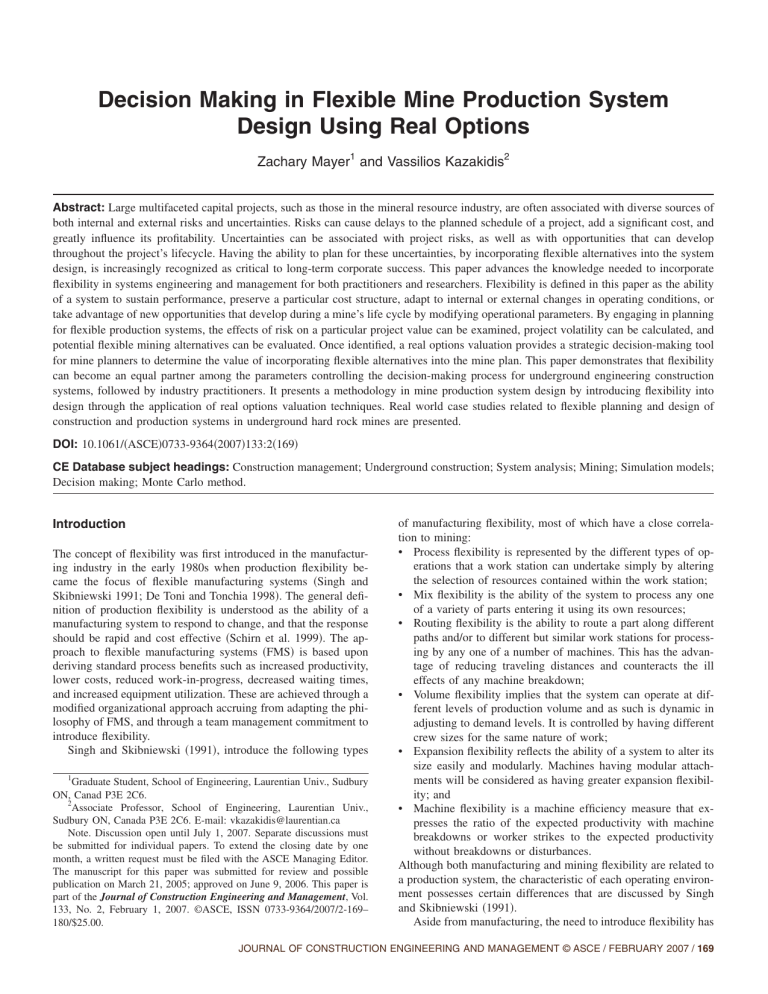
Decision Making in Flexible Mine Production System Design Using Real Options Zachary Mayer1 and Vassilios Kazakidis2 Abstract: Large multifaceted capital projects, such as those in the mineral resource industry, are often associated with diverse sources of both internal and external risks and uncertainties. Risks can cause delays to the planned schedule of a project, add a significant cost, and greatly influence its profitability. Uncertainties can be associated with project risks, as well as with opportunities that can develop throughout the project’s lifecycle. Having the ability to plan for these uncertainties, by incorporating flexible alternatives into the system design, is increasingly recognized as critical to long-term corporate success. This paper advances the knowledge needed to incorporate flexibility in systems engineering and management for both practitioners and researchers. Flexibility is defined in this paper as the ability of a system to sustain performance, preserve a particular cost structure, adapt to internal or external changes in operating conditions, or take advantage of new opportunities that develop during a mine’s life cycle by modifying operational parameters. By engaging in planning for flexible production systems, the effects of risk on a particular project value can be examined, project volatility can be calculated, and potential flexible mining alternatives can be evaluated. Once identified, a real options valuation provides a strategic decision-making tool for mine planners to determine the value of incorporating flexible alternatives into the mine plan. This paper demonstrates that flexibility can become an equal partner among the parameters controlling the decision-making process for underground engineering construction systems, followed by industry practitioners. It presents a methodology in mine production system design by introducing flexibility into design through the application of real options valuation techniques. Real world case studies related to flexible planning and design of construction and production systems in underground hard rock mines are presented. DOI: 10.1061/共ASCE兲0733-9364共2007兲133:2共169兲 CE Database subject headings: Construction management; Underground construction; System analysis; Mining; Simulation models; Decision making; Monte Carlo method. Introduction The concept of flexibility was first introduced in the manufacturing industry in the early 1980s when production flexibility became the focus of flexible manufacturing systems 共Singh and Skibniewski 1991; De Toni and Tonchia 1998兲. The general definition of production flexibility is understood as the ability of a manufacturing system to respond to change, and that the response should be rapid and cost effective 共Schirn et al. 1999兲. The approach to flexible manufacturing systems 共FMS兲 is based upon deriving standard process benefits such as increased productivity, lower costs, reduced work-in-progress, decreased waiting times, and increased equipment utilization. These are achieved through a modified organizational approach accruing from adapting the philosophy of FMS, and through a team management commitment to introduce flexibility. Singh and Skibniewski 共1991兲, introduce the following types 1 Graduate Student, School of Engineering, Laurentian Univ., Sudbury ON, Canad P3E 2C6. 2 Associate Professor, School of Engineering, Laurentian Univ., Sudbury ON, Canada P3E 2C6. E-mail: [email protected] Note. Discussion open until July 1, 2007. Separate discussions must be submitted for individual papers. To extend the closing date by one month, a written request must be filed with the ASCE Managing Editor. The manuscript for this paper was submitted for review and possible publication on March 21, 2005; approved on June 9, 2006. This paper is part of the Journal of Construction Engineering and Management, Vol. 133, No. 2, February 1, 2007. ©ASCE, ISSN 0733-9364/2007/2-169– 180/$25.00. of manufacturing flexibility, most of which have a close correlation to mining: • Process flexibility is represented by the different types of operations that a work station can undertake simply by altering the selection of resources contained within the work station; • Mix flexibility is the ability of the system to process any one of a variety of parts entering it using its own resources; • Routing flexibility is the ability to route a part along different paths and/or to different but similar work stations for processing by any one of a number of machines. This has the advantage of reducing traveling distances and counteracts the ill effects of any machine breakdown; • Volume flexibility implies that the system can operate at different levels of production volume and as such is dynamic in adjusting to demand levels. It is controlled by having different crew sizes for the same nature of work; • Expansion flexibility reflects the ability of a system to alter its size easily and modularly. Machines having modular attachments will be considered as having greater expansion flexibility; and • Machine flexibility is a machine efficiency measure that expresses the ratio of the expected productivity with machine breakdowns or worker strikes to the expected productivity without breakdowns or disturbances. Although both manufacturing and mining flexibility are related to a production system, the characteristic of each operating environment possesses certain differences that are discussed by Singh and Skibniewski 共1991兲. Aside from manufacturing, the need to introduce flexibility has JOURNAL OF CONSTRUCTION ENGINEERING AND MANAGEMENT © ASCE / FEBRUARY 2007 / 169 also been identified in finance, 共e.g., stocks and bonds兲, to commodities 共e.g., oil, grain, and foreign exchange兲, and services, 共e.g., electric power, communications兲, to research, product development, system modularity, and civil engineering applications 共De Neufville 2003; De Neufville et al. 2006; Zhao et al. 2004兲. According to Dunbar et al. 共1998兲, flexibility in mining is a measure of the capabilities of a mine production system or a mining company to respond to changes. It is “the ability to adapt a system’s design or operation to fluctuating conditions,” 共Ku 1995兲. In defining flexibility, Schirn et al. 共1999兲, state that: • Flexibility is the ability to deal with variability and uncertainty; • The sources of variability and uncertainty can either be planned or unplanned and due to internal or external events; • The ability to respond, or be flexible, should be considered in two dimensions: range and speed of response; and • Flexibility is considered within a number of time frames, corresponding to the strategic, tactical and operational planning levels. Based on the literature review presented above, the writers of this paper stipulated the following definition of flexibility for the analysis presented herein: Flexibility is defined as the ability of a system to sustain performance, preserve a particular cost structure, adapt to internal or external changes in operating conditions, or take advantage of new opportunities that develop during a mine life cycle by modifying operational parameters. The main contribution of this paper is the introduction of a methodology to evaluate flexible alternatives as they relate to decision making in underground mine design by using simulation as well as real options valuation methods. This work demonstrates that flexibility is a valuable asset in more than one way, as it shows that the value of a project is closely associated with fluctuations in operating and market conditions, and that mine planners must be more aware of these matters in order to design and plan appropriately. The work introduced in this paper is relevant to practitioners and researchers in underground construction, production management, and engineering system analysis. Uncertainty in Mining Projects and the Need for Flexibility Underground mine design typically follows an iterative process where potential mining methods are considered, optimum production capacities determined, and indicative cutoffs derived. Preferred mining methods are selected, followed by more refined ore definition that is often obtained from borehole data that represents only a small fragment of the actual orebody. Primary infrastructure options are then established and the analysis taken through to global extraction sequencing. It is clear that the uncertainty of operating conditions is inherent in mine production planning and scheduling. Traditionally, the introduction of flexibility into mine design has only been done intuitively during the feasibility stages of the project. The mine planning and design team often relies solely on their own judgment and experience to determine the areas of the project where flexibility should be included. Currently, there is no formalized process to quantify the value of flexible alternatives in a mine plan 共Kazakidis and Scoble 2003兲. A typical mining operation presents economic, operating, and environmental challenges. Uncertainty in a mining project is commonly evaluated with respect to internal 共endogenous兲 and external 共exogenous兲 conditions, as shown in Fig. 1. The focus of this paper is the consideration of economic parameters as they relate Fig. 1. Sources of uncertainty in mining projects 共Kazakidis 2001兲 to internal conditions governed by the deposit and the mining method itself, such as grade, ground behavior, workforce, management, schedule, equipment, and infrastructure. The actual return on investment usually differs substantially from that determined in the feasibility study, because of the probability of errors in estimating capital costs, ore reserves, operating costs, mineral revenue, and operating productivity 共O’Hara 1982兲. Incorporating flexibility into the mine plan devised during a feasibility study can help control these errors, and gives management the option to reduce them significantly. Risk management is becoming increasingly important, not least from the safety perspective. Uncertainty has always been a factor in mining and many decisions traditionally rely on the experience and judgment of mine operators 共Horsley and Medhurst 2000兲. Applicable risk and decision-making methods are well established and their use can significantly improve decisions 共Cairns 1982; Kral 1993; Roberts et al. 1996; Simonsen and Perry 1999; Breyfogle 1999, Summers 2000兲. Due to the uncertainties inherent in the environment in which mines are planned and developed, it is a given that the introduction of flexibility is essential for the management of risk, maintenance of low costs, and the preservation of a particular cost structure. In cases where the uncertainty or risk related to a particular component of a mining system cannot be readily lowered by design improvisations, it is important that a flexible contingency plan be devised to accommodate the factors that can seriously affect production rates or costs, and to adapt to these changes. Although it is not always an easy task to estimate the likelihood of a failure to occur in a production system, it is possible to estimate the consequences of such a failure and to have a contingency plan in place. The larger the degree of uncertainty, the more valuable flexibility becomes. Incorporation of flexibility into mine plans will require identification of the applicable areas of a mining system. It was Cavender 共2000兲 who pointed out that flexibility is introduced to counter an event that would have a negative impact on one or more of: production volume; yields 共recovery兲; product quality 共grade兲; production costs; and specified performance. Contingency is often introduced in plans to counter that inadequacy of information available, when an informed decision under time constraints is required. In that sense, it is worth mentioning that contingency constitutes a special application of flexibility in engineering. Roberts et al. 共1996兲 state that “contingency plans involve the paradoxical enactment of a decision before the decision is actually made.” A plan is chosen contingent upon the acquisition of outstanding information, or upon the occurrence of a trigger event. Historically, in a contingency planning protocol, the following process steps have often been followed: • Identify and articulate the problems to be solved; • Identify alternative solutions; 170 / JOURNAL OF CONSTRUCTION ENGINEERING AND MANAGEMENT © ASCE / FEBRUARY 2007 Fig. 2. Examples of direct implementation of flexibility into a mine plan • Choose decision criteria; • Justify alternatives; • Plan contingencies; • Enact contingency plans; • Evaluate contingency plans; and • Evaluate conditional decisions. Production simulation is an integral part of mining operations, since it enables the analysis of complex production systems. Since its introduction to the mining industry 20 years ago, simulation has found application in understanding the controlling parameters affecting production; evaluating alternatives; predicting the course and results of certain actions; understanding why observed events occur; identifying problem areas before implementation; exploring the effects of modifications; confirming that all variables are known; evaluating ideas and alternatives; identifying inefficiencies; gaining insight and stimulating creative thinking; communicating the integrity, and feasibility of existing plans 共Kazakidis and Dessureault 2004兲. Flexibility assessment has not been examined in a systematic way as part of production simulation, although it has often been introduced intuitively in mine plans. Examples of potential direct implementation of flexibility into a mine plan are presented in Fig. 2 and can be used as a basis to evaluate alternative scenarios using production simulation. Although some of the fundamentals are understood, the methodology to introduce flexibility has not yet been established. Prior to enacting a new methodology in engineering design, this methodology needs to be well understood and broadly accepted. De Neufville 共2003兲, states that introducing flexibility into planning and design requires a new methodology that entails a deep, almost revolutionary, change in the way designers think about technology, management, and design. In addition to being a valuable asset, flexibility forces designers to: • Recognize that the value of the project is integrally associated with the fluctuations of the market 共or operating conditions兲 and thus, that they need to be closely in touch with these matters in order to design appropriately; • Understand that uncertainty is not always a risk to be avoided, but also presents valuable opportunities that can be exploited; • Adopt a proactive stance towards risk, looking not just to respond to it passively, but to manage it proactively through the use of real options; and • Introduce far more flexibility into the design of systems than has been the norm. The review shown above demonstrates that flexibility needs to become an integral part of design to counter the uncertainty associated with engineering projects. Overall, flexibility provides a means for mine management to improve its decision-making process by introducing appropriate measures in an uncertain environment. In the past, the application of flexibility to mining projects with uncertainty due to market risks has been explored. However the analysis of flexibility related to internal project operating risk factors have not been examined to the same extent 共Singh and Skibniewski 1991; Kajner and Sparks 1992; Trigeorgis 1998; Dunbar et al. 1998兲. Real Options Applications to Engineering Design While the bulk of real options literature focused on analysis of evaluation of strategic economic alternatives, little focus has been given to analyses that address the needs of flexible engineering design. Samis and Poulin 共1998兲, state that “the value of a mining project is typically influenced by many underlying economic and physical uncertainties, a dynamic project risk structure built on top of these uncertainties, and the possibility of multiple and mutually exclusive project operational options.” It has been postulated that mining projects are planned and constructed in an uncertain physical and economic environment. Ewert and Couillard 共2003兲 state that a real option is the managerial flexibility and right, but not the obligation, to take action to influence the value of a real asset. A real option valuation is the application of option pricing theory to the valuation of real assets as opposed to financial assets. Financial options derive their value from the value of the underlying financial asset 共for instance, a stock兲, whereas a real option value is based on the present value of the cash flows provided by the investment opportunity 共Cobb and Charnes 2004兲. In finance, individual real options are commonly classified 共Leslie and Michaels 1997; Copeland and Keenan 1998兲 into growth options 共e.g., scaling up, switching up, or scoping up a project兲, deferral/learning options, and abandonment options, 共e.g., shutting down, scaling down, switching JOURNAL OF CONSTRUCTION ENGINEERING AND MANAGEMENT © ASCE / FEBRUARY 2007 / 171 Table 1. Basic Variables Required for a Real Option Valuation The value of the underlying risky asset In mining, this would be the value of the project 共or investment兲 in question. If the value of the underlying asset 共e.g., metal price兲 goes up, so does the value of the call option 共e.g., expansion兲. The exercise price This is the amount of money invested to exercise the option 共e.g., the cost required to expand the mining operation, or to abandon it兲 if you are “buying” the asset 共call option: expand兲, or the amount of money received if you are “selling” it 共put option: abandon兲. As the exercise price of an option increases the call option decreases, and the value of the put increases. As the time to expiration increases, so does the value of the option. The standard deviation of the value of the underlying risky asset. The value of the option increases with the riskiness of the underlying asset. For example, in mining, the market price of nickel is historically volatile 共greater than 30%兲, which introduces high market risk into the project, and therefore, increases the value of the option. The risk-free rate is a theoretical interest rate at which an investment may earn interest without incurring any risk. The risk-free rate is also known as the short-term treasury rate, or bond rate. As the risk-free rate goes up, the value of the option also increases. The time to expiration of the option The volatility of the underlying asset The risk-free rate of interest down, or scoping down a project兲. Similarly, types of flexibilities that can be embedded into a mineral project can include: • Cancellation during construction 共e.g., in case mineral prices turn particularly unfavorable兲; • Expansion 共e.g., at a given time, management can decide to expand production capacity兲; • Abandonment 共e.g., at any time the entire project may be abandoned for its salvage value, or simply shut down as a safeguard against possible future losses兲; and • Deferral 共e.g., project initiation may be delayed for a certain time without any adverse consequences, i.e., competitive兲. Real options are important in strategic and financial analysis because traditional valuation tools such as discounted cash flow 共DCF兲 ignore the value of flexibility. Real options can provide a systematic framework that also serves as a strategic tool, and it is in this strategic application that the real power of real options lies. When a situation involves great uncertainty and managers need flexibility to respond, real option valuation becomes applicable. If the decision being made involves low uncertainty, or if there is no scope to change course when new information is acquired, then determination of the net present value 共NPV兲 and rate of return 共ROR兲 of a project using traditional DCF techniques would be sufficient. If not, the application of real options can prove to be very important 共Copeland and Keenan 1998兲. A general real options framework proposed by Luehrman 共1998兲 involves the following steps: • Recognize the option and describe it; • Map the project’s characteristics onto option variables; • Rearrange the DCF projections; • Establish a benchmark option value based on the rearranged DCF analysis; • Attach values to the option-pricing variables; and • Look up the option value as a percentage of asset value. The processes introduced for real options valuation need to be customized to the nature and the needs of engineering design in order to have a pertinent impact on the decision-making process. System analysis is one or the parameters that critically affects the decision-making process in engineering design. De Neufville 共2003兲 states that incorporating flexibility to production system analysis will add two significant dimensions to design: • Large classes of projects become much more valuable than they seem to be; these include those that enable further development without committing to it prematurely, such as research, product development, system modularity, exploratory mining, etc.; and • New classes of design alternatives, specifically those enabling managers to adjust the system as needed when relevant information becomes available, that is, design alternatives that involve deferral, acceleration, and closure of facilities. The review outlined above demonstrates the principles by which an approach should be governed in order to ensure the applicability of real options to engineering design. Adjustments to the initial framework offered by traditional valuation methods need to be implemented to render a methodology appropriate for the valuation of flexible alternatives in engineering design. Real options valuation methods commonly used in the literature will be described briefly prior to introducing applications to decision making in mine engineering design. Real Options Valuation Methods Mun 共2002兲, indicates that there are multiple methodologies and approaches that can be used to calculate an option’s value. Such methods include closed-form equations 共Black-Scholes 1973; Bjerksun and Stensland 1993兲, Monte Carlo path dependent simulation models, lattices and decision trees, partial differential equations, variance reduction, and other numerical methods. The methods used for calculating the option values in the examples and case studies presented in this paper include: • Simulation method, 共Winston 2004兲; and • Cash Flow Simulation methods, 共Kazakidis 2001; Samis and Davis 2004; De Neufville et al. 2006兲. Fig. 3. Layout of the mining zone and required infrastructure upgrades 172 / JOURNAL OF CONSTRUCTION ENGINEERING AND MANAGEMENT © ASCE / FEBRUARY 2007 Fig. 4. Expansion simulation example 共adapted from Winston 2004兲 It has been postulated that an option is a right, but not an obligation, to take an action 共e.g., expand, defer, abandon兲 at a predetermined cost, and at a predetermined period of time. Copeland and Antikarov 共2003兲 state that “options that can be exercised only on their maturity date are called European options, and those that can be exercised any time during their life are called American options.” As well, a call option is the right to buy the underlying asset by paying the exercise price. At the time of exercise, the profit on the option is the difference between the value of the underlying asset and the exercise price. A put option, however, is the right to sell the underlying asset to receive the exercise price. “Operational options are often termed real options to emphasize that they involve real activities or real commodities, as opposed to purely financial commodities” 共Luenberger 1998兲. According to Copeland and Antikarov 共2003兲 and Mun 共2002兲 the value of real options depends on five basic variables as shown in Table 1. Each of these variables plays a key role in the calculation of the value of the option, and it will be seen that the majority of the valuation methods for real options use similar input parameters, and vary only in the mathematical formulation applied. Overall, a decision to introduce a contingency component or flexible design will be a factor of the project volatility, the cost of introducing the alternative option and the quantified benefit. Two methods based on Monte Carlo simulation are discussed below: Simplified Monte Carlo Simulation Method The Monte-Carlo simulation analysis introduced by Winston 共2004兲, is a simplified model that enables the user to value quantities that derive their value from an underlying asset. This approach uses the Brownian motion to simulate the future value of an underlying asset, which is growing at a risk-free rate and that is influenced by its volatility. The output of this process is the discounted value of the payoff共s兲 received. This method can be used to simulate abandonment, postponement, expansion, contraction, and other complex options. It relates to the entire project parameters 共NPV, etc.兲, making the required inputs simple. In the majority of cases, the inputs required in this valuation method are the value of the underlying asset, the exercise price, the exercise time of the option, the volatility, and the risk-free rate. Depending on the type of option, other parameters might be required. For example, in the case of an expansion option, an expansion factor would be required, that is, a multiplier that determines the new project value if expansion occurs. In EXCEL the model contains a conditional maximum 共MAX兲 statement, which triggers an expansion if, and only if, the value of the project with expansion is higher than the value of the project without expansion. When random sampling is done using Monte Carlo simulation, the range Fig. 5. Value of flexibility versus expansion costs for various volatilities JOURNAL OF CONSTRUCTION ENGINEERING AND MANAGEMENT © ASCE / FEBRUARY 2007 / 173 Fig. 6. Project values for various market volatilities with $6 million expansion at Year 5 in potential project values, as well as the average value of flexibility is obtained for the given input parameters. Cash Flow Simulation Method The cash flow simulation method involves the creation of a relatively simple monthly or annualized cash flow spreadsheet with a conditional statement, 共e.g., IF, MAX, MIN兲, embedded in the model to make a decision based on the simulated cash flows. Monte Carlo simulation is used to forecast revenue and cost data based on an initial metal price, by using the annualized volatility. The result is a NPV based on the cash flows generated by the simulation over the time frame of the project. Common decisions to model are opportunity 共e.g., expansion兲 options, 共De Neufville et al. 2006兲, and insurance 共e.g., abandonment兲 options, 共Kazakidis 2001; Samis and Davis 2004兲. These models require a trigger to activate the option. In previous work using cash flow simulation methods, expansion options have been triggered by high demand, 共e.g., if demand is higher than current production, then expand兲, or by high metal prices, 共e.g., if metal price has exceeded a certain benchmark, then expand兲. Abandonment options have been triggered by similar means, 共e.g., production cost has exceeded the amount of revenues generated, so abandon; or, metal price has dropped below a specific value so abandon兲. These triggers are embedded into a spreadsheet using conditional statements to make the decisions, and can be tailored to suit any specific problem. The value of flexibility is obtained by comparing the results of two different spreadsheets. When the conditional statement is removed from the spreadsheet, there is no longer an option available. Therefore, by comparing the Monte Carlo results from a spreadsheet with the conditional statement, and one without it, the difference between the two NPV values is the value of flexibility. Case Studies Case Study 1: Capacity Option An underground mine is evaluating the option of opening a new mining zone. The recommendations from the prefeasibility study suggest that upgrades be considered to the shaft, skip, hoisting station, and crusher, as well as to construct a new orepass to handle the extra ore produced from the new mining zone 共Mayer 2004兲. The completion of these necessary upgrades will cost the company $68 million over three years. During these three years of Fig. 7. Cash flow simulation example—no option to abandon 174 / JOURNAL OF CONSTRUCTION ENGINEERING AND MANAGEMENT © ASCE / FEBRUARY 2007 Fig. 8. Cash flow simulation example—with option to abandon upgrading and predevelopment, production in the new zone will be approximately 1,170 t / day by hauling the ore to surface using trucks on a preexisting ramp. At the beginning of the third year, when upgrades and construction are completed, the mining zone will produce 5,000 t / day, generating a NPV of $24.4 million during 16 years of production. While upgrading the hoisting infrastructure during the first three years, the company has the ability to increase the hosting capacity to 6,000 t / day instead of the currently planned for 5,000 t / day. This initial upgrade would in turn give the company the option to pay an extra $6 million for additional orepass and crusher upgrades at Year 3, or later to expand production to 6,000 t / day, without interrupting the hoisting system operation. The company has two alternatives: The first would be to implement the initial extra shaft upgrades that would give them the flexibility to pay the $6 million for the future production expansion to 6,000 t / day. The second alternative would simply be to go through with only the originally planned upgrades, and maintain the status quo at 5,000 t / day. The question is, under what condition would it be beneficial to introduce the flexible capacity provided by the first alternative? A layout of the mining zone and necessary upgrades is shown in Fig. 3. For this problem, the input parameters that are required for the real options valuation include the project investment cost, the revenues generated by the project, and the risk-free rate. The other variable factors used in the sensitivity analysis are the expansion time, the expansion cost, the expansion factor, and the project volatility 共which in this case is controlled mainly by the underlying risky asset which is the nickel price兲. The expansion factor is the added percent increase in the project’s NPV due to the expansion. Before any calculation can be done, this value must be obtained. For this example, the expansion factor of 9.05% is the increased difference in NPV caused by expanding production by 20% to 6,000 t / day up from 5,000 t / day at Year 3. Because the ore tonnage contained in this zone is fixed, any increase in production will speed up the time frame of the project. In this case, the increase in the project’s NPV is due to the reduction in time only, resulting in a modest increase in NPV, given by the expansion factor of 9.05%. Fig. 4 depicts a random Monte Carlo simulation run in EXCEL 共Winston 2004兲 using the following variable inputs: potential expansion in three years time, costing $6 million for crusher and orepass expansion. A 9.05% expansion factor, and 80% project volatility are also considered. The results generated by this single simulation run shows that, in this case, the value of this expansion is worth − $ 3.453 million, thereby making this option not worthwhile. It is important to note, however, that Fig. 4 depicts the results of only a single possible path that the stochastic simulation process can take. For this run, the cost of expanding is too high to justify the added value created by the expansion. To get an accurate option value, the model would normally be simulated 20,000 times and the average value used. In this case, the average result for the value of flexibility after 20,000 simulation runs is $0.652 million, thereby making expansion worthwhile. A sensitivity analysis with respect to the expansion cost, expansion time, and project volatility was undertaken to determine how the value of the expansion option is affected by these param- Fig. 9. Revenues and costs per year for 共a兲 project with no option; 共b兲 project with option to abandon JOURNAL OF CONSTRUCTION ENGINEERING AND MANAGEMENT © ASCE / FEBRUARY 2007 / 175 Fig. 10. Distribution of NPVs for no options and with option to abandon eters. One of the first sensitivity analyses undertaken was to determine the ideal expansion time 共year兲 based on a $6 million planned expansion cost, and for various project volatilities. It was determined that an expansion at Year 5 yields a higher value of flexibility, especially if the project volatility is high, 共60% or more兲. The reason why a higher volatility increases the value of the option is that uncertainty adds value to an option. With high volatility, the possibility exists that metal prices will rise, and flexibility allows a company to maximize potential revenues by expanding when the time is right. Since Year 5 appears to be the optimal expansion time, another sensitivity analysis was completed to determine the value of flexibility at Year 5 based on different expansion costs, and for varying project volatilities as shown in Fig. 5. It can be seen that with increasing expansion costs, the value of flexibility added to the project diminishes. Again, for a project with a relatively low volatility, 共30% or less兲, a $6 million dollar expansion is not worthwhile. Fig. 6 shows a summary of the project value obtained based on an operation expansion at Year 5. Case Study 2: Shutdown Option The following is an abandonment option example based on a mine expected to operate for ten years. The risk-free rate is 5%, the annual revenue volatility is 40%, the annual cost volatility is 10%, and at Year 1 the metal price is $4.00/lb. The mine produces 60,000 t of 1.82% grade ore per year. The mine has the option to abandon production at any given year for a cost of $100,000. Fig. 7 shows the expected cash flows generated by the project for a single simulation run with no option to abandon. The analysis is based on a methodology proposed by De Neufville et al. 共2006兲. For this model, the metal price and operating costs are simulated for the future periods using the Brownian Motion. Alternatively, it is possible to use a mean-reverting model for the metal prices 共Copeland and Antikarov 2003; Samis and Davis 2004兲. In this case, at Year 4 the metal price begins to drop, which causes the operating costs to exceed the revenues generated. The final NPV in this case is − $ 0.743 million, thereby making the project unprofitable under these simulated conditions. However, the option to abandon production at any year, if metal prices become unfavorable, can improve the project profitability. Fig. 8 shows the expected cash flows for the exact same project, with the option to abandon embedded in the spreadsheet. In this case, as soon as the market price drops enough to make the operating costs exceed the revenues, in Year 4, the project is abandoned. From Fig. 8, the resulting NPV with the option to abandon is $6.156 million. Compared to the NPV with no option, this abandonment option adds a significant value to the project. Fig. 9 depicts graphs representing the operating costs and revenues per period for the project with no option, and for the project with the abandonment option incorporated respectively. When examining Fig. 9, it is evident that the project with no option to abandon is operating at a loss from Year 4 and on. The losses incurred after Year 4 are simply too large to maintain a profitable project. However, as soon as the revenues dip below the costs at Year 4, the project is abandoned. This flexibility to shut down operations saves the company the losses that they would otherwise incur had they continued to mine. It is clear that this insurance type of flexibility adds a significant value to the project. Monte Carlo simulation was employed to determine the average value of abandonment flexibility for this project after 10,000 simulation runs. Histograms and cumulative frequency charts depicting the range of NPV data were obtained for the two scenarios, as shown in Fig. 10. It can be seen that the option to shutdown essentially cuts off the low NPV from occurring. As a result, the mean NPV increases from $2.4 million for a project with no flexibility, to $5.1 million for the project that has the flexibility to abandon. Therefore, based on the analysis, it is desirable to introduce this particular option. Case Study 3: Sequence Decision Option Fig. 11. 共a兲 Full development; 共b兲 gradual development mining sequences A real options valuation for the case of a mine production decision in times of high market uncertainty is considered. The mine 176 / JOURNAL OF CONSTRUCTION ENGINEERING AND MANAGEMENT © ASCE / FEBRUARY 2007 Fig. 12. Volatility sensitivity on project value for borderline expansion scenario Fig. 14. Comparison of expansion and shutdown effect on project value must decide which of two possible mining sequences to implement for mining the zone. The first sequence is a full development mining sequence, which lends itself well to the opportunity option of expanding production by taking advantage of rising metal prices. The second possible sequence is a gradual development mining sequence, which is an insurance method that lends itself well to the option of shutting down operations, as a protection against losses caused by a decreasing metal price. The full development sequence requires the orebody to be mined from the bottom up, whereas the gradual development sequence requires it to be mined from the top down. Each of these sequences involves different logistical issues, as well as mining costs unique to the method. A real options valuation on the two scenarios will help the mine decide which method to implement while recognizing the value of flexibility. The mining zone, shown in Fig. 11, is a near vertical tabular orebody containing approximately 104,390 t of 3.05% nickel and 1.66% copper ore. The orebody, situated approximately 1,000 m deep has a vertical height of 130 m, a strike length of 150 m, and a width varying between 1 and 3 m that pinches out along the western edge of the orebody. The mining zone contains ten development levels connected by a spiral ramp 共Mayer 2004兲. A model of the ten-level mining zone was created using the EXTEND software. EXTEND is an object-oriented discrete event simulation software that has been used in the past 共Dunbar et al. 1998; Kazakidis and Dessureault 2004兲 to simulate simple layouts of multivariable materials handling problems in mines. The discrete-event simulation model that was created enables the detailed analysis of a complex production system created using actual operating, production, scheduling, and costing data. The simulation model allowed for the outputting of project revenues, volatilities, and time frames, for a variety of simulated scenarios. Analysis Sequence I: Real Option Valuation for Full Development Sequence „Opportunity Option… The expansion scenario involves a decision made by mine management during the construction of the ramp, to increase the number of mining crews from the initial one crew, to a three-crew operation. This decision to expand would be made on the basis of the market volatility, as in an upward trend in metal price, which would give the company a beneficial reason to expand by taking advantage of the market upturn in order to maximize profits. A sensitivity analysis was conducted on this model to determine the effects different project volatilities and expansion costs had on the overall project value. It was found that with a project volatility of 20%, expansion is not worthwhile for an expansion cost above $0.8 million. In the case of a project with 40% volatility, the option to expand is worthwhile as long as the expansion cost is under $1.2 million. Fig. 12 represents the trend in project value, as it is affected by varying project volatilities with an expansion cost of $1 million. Once again, with increasing project volatility, the expansion option adds more value to the project. In this case, with a volatility Fig. 13. Value of flexibility per level for various project volatilities JOURNAL OF CONSTRUCTION ENGINEERING AND MANAGEMENT © ASCE / FEBRUARY 2007 / 177 Fig. 15. Proposed methodology flow sheet of 140%, the project value can go from $1.81 million, by maintaining the status quo, to $2.2 million by exercising the option to expand, as soon as the ramp is complete. Analysis Sequence II: Real Option Valuation for Gradual Development Sequence „Insurance Option… The shutdown scenario involves a decision made by mine management with the completion of mining at each level, to shutdown mining indefinitely if conditions call for it. This decision would be made on the basis of market volatility, or due to a downward trend in the metal price, which makes the project unfeasible to continue. The minimum commitment of the gradual development scenario acts as an “insurance” to the project. The value of shutting down varies depending on how far along into the project the company decides to shutdown. It can be seen in Fig. 13 that the value of flexibility gradually increases with time, then eventually peaks and tapers down at the end of the project. The reason for this trend is that the value of flexibility increases with time, since uncertainty increases with time. However, as mining progresses, the orebody is being gradually depleted, which is what causes the tapering effect of the value of flexibility. It should also be noted that these are all individual European option values, and the mine would have to exercise the option to shut down at only one of these times. Fig. 14 presents the results obtained from the real options valuation from both sequences for decision-making purposes. Determining which of the two development scenarios to introduce in the mine can also prove to be a challenge for the company. Would the mine rather have the option of taking advantage of new opportunities as they arise, or would they rather have the ability to safeguard against a potential loss? It can be seen that the gradual development scenario yields a higher project value then the full development scenario. This shows that for the case study considered, the value of protecting an investment from loss is worth more than the value of trying to increase the investment by expanding operations. Methodology A methodology that incorporates flexibility into the mine planning process to better manage the effects of internal and external risks and uncertainties is proposed. In a real options valuation process, it is essential for mine management to be able to identify risks, determine their likelihood, examine their effects by using simulation, determine flexible alternatives, and use real options valuation to establish their value. It is also important that it is known which real options valuation method to chose based on the analysis required and the data available. A flow sheet of the proposed methodology is presented in Fig. 15. The four main steps in the proposed methodology, shown in Fig. 15, are as follows: • Risk identification; • Process simulation; • Formulate flexible alternatives; and • Real options analysis. This rudimentary methodology can be used to assist in the decision-making process by following the outlined steps: Step 1: Risk Identification Identify potential uncertainties that are relevant to the project in question. A typical risk assessment methodology consists of a search for the answers to: What can happen; how likely is it that it can happen; and what are the consequences if it does happen? Risk management requires an understanding of how risks and uncertainties can be reduced, the cost of reducing them, and the improvement in project value likely to result from risk reduction. A variety of simulation techniques can be used to assess the risk factors and uncertainties in a mining project. Step 2: Process Simulation An ideal vehicle to examine the effects of risks on a complex production system is through the application of discrete-event simulation, which includes the integration of risk and discounted cash flow analysis. It is recommended that a simulation model be created to assess both production as well as economic data. Such 178 / JOURNAL OF CONSTRUCTION ENGINEERING AND MANAGEMENT © ASCE / FEBRUARY 2007 a model can show the direct impact of various risks on revenues, costs, and other variables, directly in the simulation model. It is at this point that the user must foresee and examine possible problems that can occur in the mine due to risk factors. Depending on the range of risks, the consequences they have on the value of the mining project can be quite broad. Simulation is also important to determine how the potential risk reduction methods affect the overall project value or costs. Step 3: Formulate Flexible Alternatives The next step in the methodology is to formulate possible flexible alternatives that can be used to counteract the negative effects of the risks, or to take advantage of new opportunities from uncertainties. It is also important to determine under what operating or financial conditions the flexible alternative will be triggered, as well as how much it might cost to do so. In some cases, the cost of exercising the option might be very low, and in other cases very high. If applicable, other types of flexibility can also be examined, such as the option to postpone investment, to defer a project, to scale down, to contract, to maintain production or cost targets, etc. Step 4: Real Options Analysis When potential flexible alternatives have been formulated, the next step is to use real options valuations to determine the value of incorporating flexibility. When evaluating flexible alternatives in a real options analysis it should be kept in mind that “. . . flexibility is evasive because it is a potential, which depends on what happens in the future. However, the future, is shrouded in uncertainty, which in the strictest sense cannot be measured or predicted with accuracy. Therefore, the value of flexibility is difficult to ascertain” 共Ku 1995兲. Sensitivity of “what if” analyses can also be conducted in real options analysis to facilitate decision-making. Practical Applications The following practical applications are envisaged for the construction industry: • Optimization of resource requirements in construction projects 共crew/fleet兲 to accommodate the need for variable capacity requirements in a particular project; • Evaluation of planning or equipment alternatives when flexibility is a controlling variable in a decision-making process; • The justification of a new piece of equipment on the basis of flexibility needed as this relates to the operating uncertainty and the capital/operating costs; • Resource availability 共personnel, equipment兲 to handle problems and counter potential project delays; • The need to introduce training options for multitasking or handling of particular problems; • The justification of needs in contingency planning by linking the operating/market risk in a project and the value/cost of flexible alternatives; and • The ability to introduce in the future an optional change in a project parameter 共alternative plan兲. Conclusions Mining projects require the management of several sources of uncertainty. Metal prices, mineral reserves, ground conditions, and countless other variables, create a high-risk environment in which to operate. This research has introduced a practical way of using real options to evaluate flexible alternatives that can contain internal and external risks, which affect mine production and profitability. It has introduced a means to calculate the expected value, given a set of assumptions, as well as the value added by flexibility into a mine plan for decision-making purposes. Although, to date, real options have been applied mainly on a corporate level in mining, the research presented herein has demonstrated that the use of real options is viable from the production and design standpoint to engineering and construction management in mines as well. Acknowledgments Funding for this work was provided by the National Research Council of Canada. The writers would like to express their appreciation to Falconbridge Ltd. and Inco Ltd. for the case study data they provided. References Bjerksund, P., and Stensland, G. 共1993兲. “Closed-form approximation of American options.” Scandinavian J. Management, 9, 87–99. Black, F., and Scholes, M. 共1973兲. “The pricing of options and corporate liabilities.” J. Polit. Econ., 81, 631–654. Breyfogle, F. 共1999兲. Implementing six sigma: Smarter solutions using statistical methods, Wiley, New York. Cairns, R. D. 共1982兲. “Assessment of risk in a minerals industry.” Res. Policy, 8共1兲, 59–64. Cavender, B. 共2000兲. “Rethinking the use of new technology to improve operational performance.” Min. Eng., 52共12兲, 61–67. Cobb, B. R., and Charnes, J. M. 共2004兲. “Real options volatility estimation with correlated inputs.” Eng. Econ., 49共2兲, 119–137. Copeland, T. E., and Antikarov, V. 共2003兲. Real options: A practitioner’s guide, Thompson Texere, N.Y. Copeland, T. E., and Keenan, P. T. 共1998兲. “How much is flexibility worth?” Roads Bridges, 2, 38–49. De Neufville, R. 共2003兲. “Real options: Dealing with uncertainty in systems planning and design.” Integrated Assessment, 4共1兲, 26–34. De Neufville, R., Scholtes, S., and Wang, T. 共2006兲. “Valuing real options by spreadsheet: A parking garage case example.” J. Infrastruct. Syst., 12共2兲, 107–111. De Toni, A., and Tonchia, S. 共1998兲. “Manufacturing flexibility: A literature review.” Int. J. Prod. Res., 36共6兲, 1587–1617. Dunbar, W. S., Dessureault, S., and Scoble, M. 共1998兲. “Analysis of flexible mining systems.” Int. J. Mineral Resources Engineering, 8共2兲, 165–179. Ewert, D. C., and Couillard, K. P. 共2003兲. “Real options and the value of uncertainty.” 22nd Advanced Business Valuation Conf., American Society of Appraisers, Chicago, 1–66. Horsley, T. P., and Medhurst, T. P. 共2000兲. “Quantifying geotechnical risk in the mine planning process.” Proc., MassMin 2000, AusIMM, Brisbane, Australia, 105–112. Kajner, L., and Sparks, G. 共1992兲. “Quantifying the value of flexibility when conducting stochastic mine investment analysis.” Canadian Institute of Mining and Metallurgy Bulletin, 85共964兲, 68–71. Kazakidis, V. 共2001兲. “Operating risk: Planning for flexible mining systems.” Ph.D. dissertation, Univ. of British Columbia. Kazakidis, V., and Dessureault, S. 共2004兲. “Incorporating ground delays in underground mine production system simulation.” SME Transactions, Society for Mining, Metallurgy and Exploration, 316, 51–57. Kazakidis, V., and Scoble, M. 共2003兲. “Planning for flexibility in underground mine production systems.” Min. Eng., 55共8兲, 33–39. Ku, A. 共1995兲. “Modeling uncertainty in electricity capacity planning.” JOURNAL OF CONSTRUCTION ENGINEERING AND MANAGEMENT © ASCE / FEBRUARY 2007 / 179 Ph.D. dissertation, Univ. of London, London. Kral, S. 共1993兲. “Risk assessment/management in the environmental planning of mines.” Min. Eng., 45, 151–154. Leslie, K. J., and Michaels, M. P. 共1997兲. “The real power of real options.” McKinsey Quarterly, 3, 4–22. Luehrman, T. A. 共1998兲. “Investment opportunities as real options: Getting started on the numbers.” Harvard Bus. Rev., 98404, 51–67. Luenberger, D. G. 共1998兲. Investment science, Oxford Univ., New York. Mayer, Z. 共2004兲. “Real options applications in the valuation of flexible underground mining system design alternatives.” MASc thesis, Laurentian Univ., School of Engineering. Mun, J. 共2002兲. Real options analysis: Tools and techniques for valuing strategic investments and decisions, Wiley, Hoboken, N.J. O’Hara, T. A. 共1982兲. “Analysis of risk in mining projects.” CIM Bulletin, Canadian Inst. of Mining and Metallurgy, 75共843兲, 84–90. Roberts, C., Wild, C., and Maly, K. 共1996兲. “Process for managing project uncertainty with contingency planning.” Implementing systems for supporting management decisions, P. Humphreys, L. Bannon, A. McCosh, P. Migliarese, and J. C. Pomerol, eds., Chapman Hall, New York. Samis, M., and Davis, G. 共2004兲. “An overview of using real options to value and manage mining projects: Workshop notes.” Proc., 2004 MEMS Pre-Conference Workshop, AGM, Toronto. Samis, M., and Poulin, R. 共1998兲. “Valuing management flexibility: A basis to compare the standard DCF and MAP valuation frameworks.” Canadian Institute of Mining and Metallurgy Bulletin, 91共1019兲, 69–74. Schirn, J., Efstathiou, J., Calinescu, A., Sivadasan, S., and FjeldsoeNielsen, L. 共1999兲. “A model for assessing the costs and benefits of manufacturing flexibility.” Proc., 15th National Conf. on Manufacturing Research (NCMR 2001): Advances in Manufacturing Technology XIII, Univ. of Bath, U.K., 301–305. Simonsen, H., and Perry, J. 共1999兲. “Risk identification, assessment and management in the mining and metallurgical industries.” The Journal of the South African Institute of Mining and Metallurgy, 6, 321–328. Singh, A., and Skibniewski, M. J. 共1991兲. “Development of flexible production systems for strip mining.” Mining Science and Technology, 13, 75–88. Summers, J. 共2000兲. “Analysis and management of mining risk.” Proc., MassMin 2000, AusIMM, Brisbane, Australia, 63–79. Trigeorgis, L. 共1998兲. Real options: Managerial flexibility and strategy in resource allocation, MIT Press, Cambridge, Mass. Winston, W. 共2004兲. Microsoft excel data analysis and business modeling, Microsoft, Redmond, Wash. Zhao, T., Sundararajan, S. K., and Tseng, C. 共2004兲. “Highway development decision-making under uncertainty: A real options approach.” J. Infrastruct. Syst., 10共1兲, 23–32. 180 / JOURNAL OF CONSTRUCTION ENGINEERING AND MANAGEMENT © ASCE / FEBRUARY 2007
